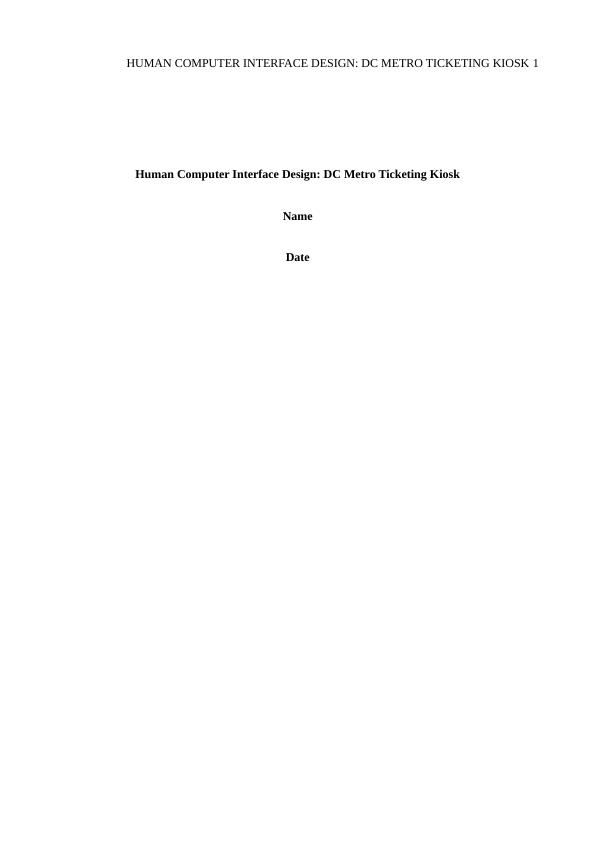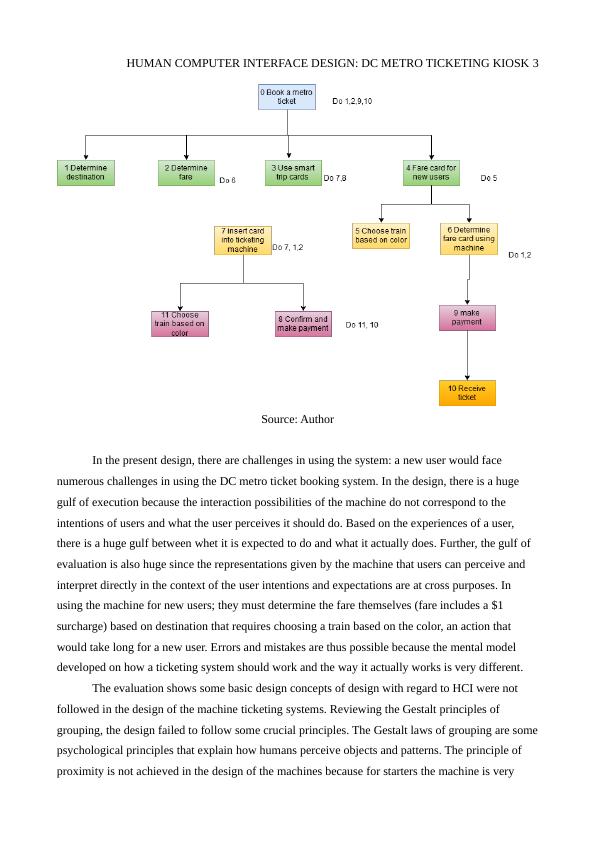Human Computer Interface Design Assignment PDF
11 Pages2107 Words39 Views
Added on 2021-04-17
Human Computer Interface Design Assignment PDF
Added on 2021-04-17
ShareRelated Documents
HUMAN COMPUTER INTERFACE DESIGN: DC METRO TICKETING KIOSK 1Human Computer Interface Design: DC Metro Ticketing KioskNameDate

HUMAN COMPUTER INTERFACE DESIGN: DC METRO TICKETING KIOSK 2Problem analysisThe DC Metro ticketing machines are large, bulky, and complicated pieces of electronic equipment that can be intimidating to a first time user, even those that have been using metro ticketing machines in other parts of the world. Part from being complicated, it is also not user friendly to use, particularly for someone that has never used it before. The machine so much information, yet based on the numbers appearing on the screen, only three steps are needed to get oneself a ticket. The design of such equipment must take into consideration human computer interaction (HCI). When at the ticketing machine, especially a new user can feel ‘lost’, and the pressures of others waiting in line and having to contend with train arrival times can make the experience stressful. According to Kurosu (2014), the theories of HCI according to Schneiderman require that designers must first recognize diversity when making designs. Based on this, the eight interface design golden rules must be adhered to: these include striving for consistency, enable shortcuts for frequent users, provide feedback, design dialogs for closure, provide error prevention and error handling, allow easy actions reversal, support for internal control locus, and ensure short term memory load is reduced (Valverde, 2011). However, these golden rules are not adhered to; there is no consistency, error prevention and handling is not inbuilt, action reversal is not easy at all,there is a lot of required short term memory, and internal locus of control is weak. Looking at the DC metro tickets, essentially, only three steps are needed to purchase, but the DC metro system has about eight steps as depicted in the hierarchical diagram below;

HUMAN COMPUTER INTERFACE DESIGN: DC METRO TICKETING KIOSK 3Source: AuthorIn the present design, there are challenges in using the system: a new user would face numerous challenges in using the DC metro ticket booking system. In the design, there is a huge gulf of execution because the interaction possibilities of the machine do not correspond to the intentions of users and what the user perceives it should do. Based on the experiences of a user, there is a huge gulf between whet it is expected to do and what it actually does. Further, the gulf of evaluation is also huge since the representations given by the machine that users can perceive and interpret directly in the context of the user intentions and expectations are at cross purposes. In using the machine for new users; they must determine the fare themselves (fare includes a $1 surcharge) based on destination that requires choosing a train based on the color, an action that would take long for a new user. Errors and mistakes are thus possible because the mental model developed on how a ticketing system should work and the way it actually works is very different. The evaluation shows some basic design concepts of design with regard to HCI were not followed in the design of the machine ticketing systems. Reviewing the Gestalt principles of grouping, the design failed to follow some crucial principles. The Gestalt laws of grouping are somepsychological principles that explain how humans perceive objects and patterns. The principle of proximity is not achieved in the design of the machines because for starters the machine is very

HUMAN COMPUTER INTERFACE DESIGN: DC METRO TICKETING KIOSK 4large with action panes being very widely spaced: The action panes are the exact places where the user must press or input information in order to proceed to the next step to complete a ticket booking accurately. According to the gestalt principles, proximity posits that shapes of objects that are close to each other appear to form a group (Marcus, 2013). In the ticket machines, the various actions to be taken and the action points are too widely spaced, courtesy of the large machine. While there is some degree of similarity, the design of the machines, even the interface and the appearance of the entire ticketing kiosk make it look like something for any other purpose other than a self-ticketing machine. The principle of similarity perception lends itself to observing stimulithat have physical resemblance so that they appear to be part of the same object. This principle explains how people differentiate between overlapping and adjacent objects based on the resemblance and texture of the items. A screen shot of the ticketing kiosk is shown below, showing the high level of dissimilarity, including color, appearance, and the user interface (Marcus, 2013). The design also violates the cardinal Gestalt principle of good continuation; the principle posits that people have the tendency to perceive every object, when two or more objects intersect, asa single uninterrupted object (Johnson, 2010). In this case study, the new user must first determine the fare, then select their destination, and entails back and forth processes instead of a seamless flow, such as entering destination, then the fare is automatically computed, and then a payment made and receipt received. The processes of tasks that culminate in the ticket being given and the appearance of the entire kiosk grossly violate this cardinal principle. The principle of common fate is also not achieved in the kiosk design; the appearance of the screen is more intimidating than inviting the user to explore. This is made worse by the time constraints where the train can arrive any time, the fear of missing the right train, and the possibility of others, who may have used the system before, standing behind a user. All these issues and facts mean that a user is likely to make mistakes, because the design of the kiosk interface and the flow of buttons, color, and even tasks fail to obey basic psychological principles as proposed by Gestalt (Johnson, 2010). A new user would be lost; there are three color codes to choose from, and these have to be gotten correctly, without any feedback from the machine or guidelines on how to get it correctly. Usually, an attendant has to come help someone, especially a new user. Development of a better InterfacePeople are living in the information age, where the use of smart phones, tablets, and computers has proliferated, so a well-designed system should be a breeze to use. The proposed design after this analysis is to completely replace the existing kiosk with a touch based computer screen that is much smaller. Further, the system should have instructions so that a new user can get to quickly use the system and understand what needs to be done to obtain a ticket. Importantly, the

End of preview
Want to access all the pages? Upload your documents or become a member.
